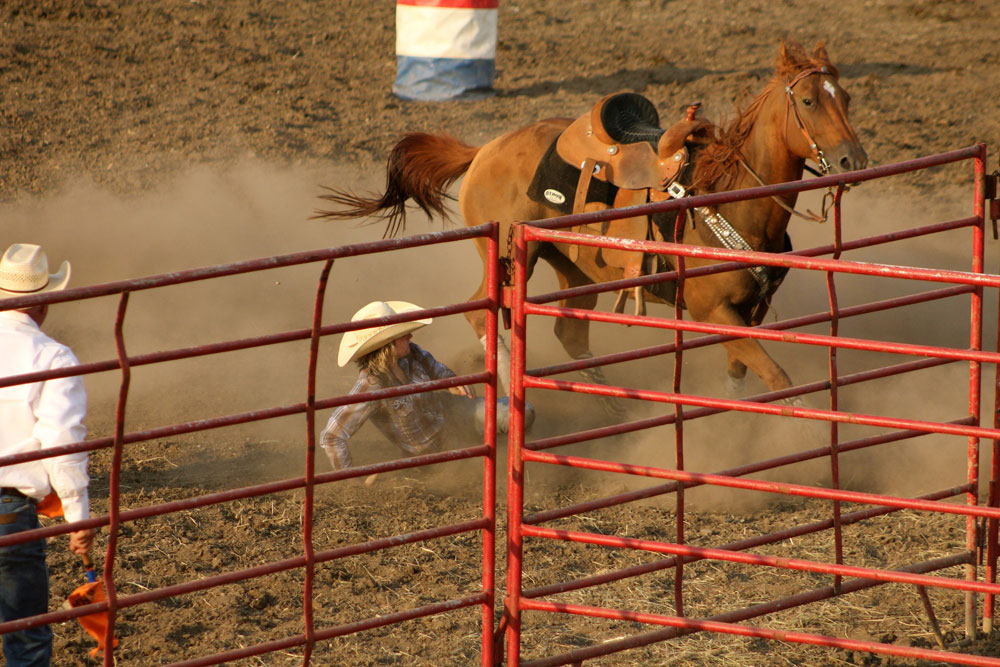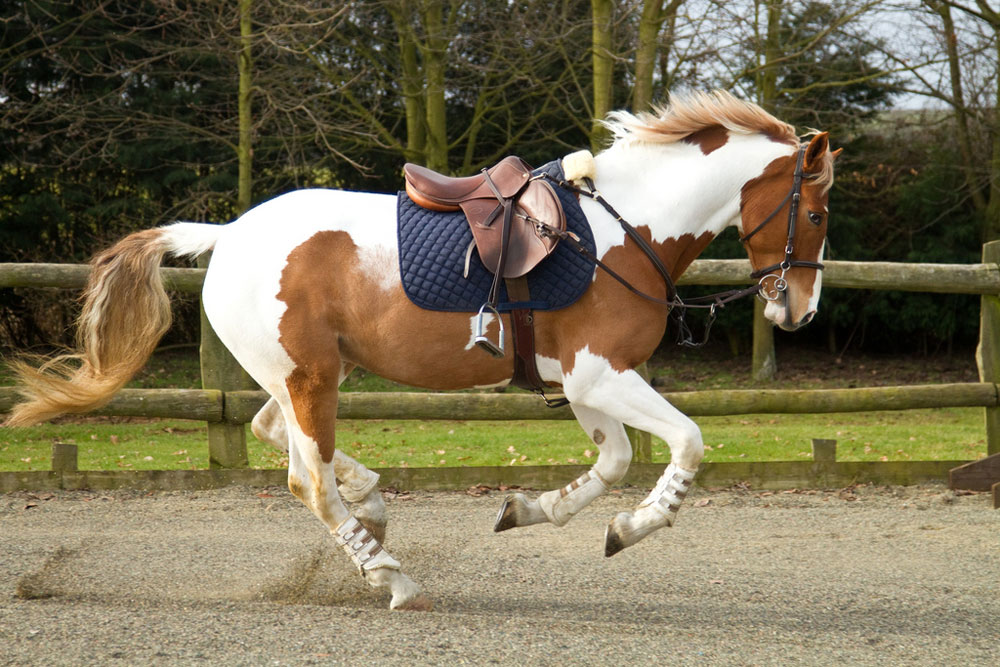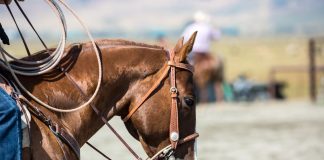Anyone who rides a horse is almost certain to fall off at some time. On most occasions these unexpected departures from the saddle are nothing more than a nuisance, and the end result is embarrassment or a dented pride, rather than physical injury. Sadly, that’s not always the case.
Not surprisingly, riders under instruction have far fewer falls than those who do their own thing, which is good news for beginners who take lessons. For example, Monica Sellers, a trainer in Lancaster, Calif., teaches at least 30 students a week, but each year, only five to 10 part company with the horse. A little further south in Hemet, instructor Pattie Roberts, who works mainly with young clients, says falls are rare.
In skydiving, gymnastics and some martial arts, learning how to fall is an essential part of basic training. Riding does not place such emphasis on falling training, despite its fairly high degree of risk. Even riders receiving regular lessons have described the amount of advice given on dealing with a fall as minimal.
“If a student is especially timid, I will discuss and validate their fears (of falling), but I don’t want to focus too much on the negative aspects of riding,” says Sellers. Maybe that explains the general feeling: Riding is about building confidence and developing a partnership, so anything that veers a rider off that course is often considered unhelpful in attaining these goals.
Emergency Exit
Several trainers and equestrian organizations do teach the emergency dismount, which can be useful in difficult situations. It’s a simple technique. The rider bends forward and wraps the arms around the horse’s neck, kicks away both stirrups, then swings a leg over the saddle and pushes away from the horse.
Riding student Lori Coulson from Ohio learned the emergency dismount during her early lessons. “This was practiced first with the horse standing, and then at a walk, and later at a trot. Once we had it right, our instructor would periodically yell, ‘fall off.’ There was no warning, but boy it sure works. In all the times I’ve come off, there’s only one where I didn’t land on my feet,” she says with pride.
There’s certainly a case that can be made for being prepared. But for the numerous riders who are not, what should they do when the awful moment comes? Roll up in a ball? Keep hold of the reins? Try to hang on and work their way back into the saddle?
Falls are the bane of steeplechase jockeys. Racing along at 25 to 30 mph over stout fences with a dozen or more horses close by carries a heavy risk. Jump jockeys try to roll up into a ball the moment they hit the ground. The body is curled up with the chin in toward the chest and the head braced with the hands. By rolling with the fall, the impact is spread, decreasing the risk of broken bones.
Jockeys always remain still. To get up and run—assuming you’re fit enough to do so—could put you at risk of being run over by the rest of the field, endangering yourself and other competitors. These techniques are also helpful for non-race riders as well, especially when other riders are following behind.
On the brief journey from saddle to ground, it’s a natural instinct to extend an arm in an effort to break the fall. Often it’s the arm or wrist that gets broken as it takes the weight of the body, along with additional forces.
“I’ve been catapulted off horses more times than I care to remember,” says Mandy Parker, a former point-to-point champion. “Instinctively I put my arm out, but always tried to relax it the moment my hand touched the ground.”
Tami Castagnoli of Colorado, who teaches children and adults, says, “I always tell students to resist the urge of reaching out with their hands. My suggestion is to let the shock be absorbed over as much of your body as possible, as opposed to breaking the fall with your hands.”
In top-level three-day eventing and show jumping, it’s common to see fallers not letting go of the reins. The general consensus, however, is that it is wrong to hold on to the reins during a fall, as this carries a high risk of injury. On landing, you may actually pull the rapidly moving horse toward your body, and that could mean being trampled by iron-clad hooves.
Time is often a vital factor in big competitions, so riders may take the risk of holding onto the horse, since swiftly remounting could put them in the prize money. Remember, too, that most are highly experienced riders who have that sixth sense of knowing when to hold on and when not to. Pattie Roberts’ advice to her students is, “If you are going to fall, let go of the horse and all equipment.”
Not all falls are of the “one moment in the saddle, the next on the ground” variety. Slow ones — where you become partially unseated and try to hang on — are another hazard. You might make it back into the saddle, but all too often the horse will make a sudden movement as you’re almost there, and off you go. In such cases, it’s often wiser to roll off at the start or resort to the emergency dismount. With all the chaos going on as you reach for the saddle, the horse may spook or panic, and there’s an added risk of becoming entangled in the horse’s legs.
The key ingredient to self-preservation will always be a generous measure of common sense. Thinking ahead, being aware of what’s going on around you, and vigilance to the possible dangers are not only vital to riding, but life in general. This all stems from the human brain—a part of the body that’s extremely vulnerable when a rider suddenly parts company with the horse.
Keeping Your Head
In Great Britain, anyone who rides without an approved helmet is considered very foolhardy by his or her peers. Even the Queen has not been spared. When newspaper photographs showed Her Majesty hacking out with only a silk scarf on her head, numerous riders wrote in and accused their monarch of failing to set a good example. Here in the United States, such attitudes can be quite the reverse, as Craig Bradley from Alabama knows only too well. He always wears a helmet when riding his Tennessee Walking Horse or Appaloosa on group trail rides, but it does cause some strange reactions.
“Some people literally think I’m a bit ‘off’ and avoid me because I have a helmet on,” Bradley says, then adds, “usually three or four people are sure to ask me about it.” He reckons only about one in 500 riders wear a helmet in his region.
Bradley is asked countless times if his helmet is hot or uncomfortable. He gives a standard reply: “I don’t even know it’s there, unless I hit a branch.”
Of course, we’ve all heard the popular excuses for riding without a helmet, “It’s my head, so it’s up to me whether I wear one or not,” or “My horse is well-behaved; he never spooks at anything,” plus numerous others in similar vein. But what if that good old horse is suddenly threatened by a galloping runaway? He’s either going to shoot out of the way fast or run the risk of a collision if he just stands there. In either situation, would you really want to be on board without any head protection?
The American Medical Equestrian Association reviewed state medical examiners’ data from 27 states, documenting 205 riding fatalities for a 10-year period. Sixty percent of those deaths were from head injuries.
When buying a helmet, there are two things to consider. It should meet American Society For Testing Materials (ASTM) standards and be certified by the Safety Equipment Institute (SEI). It must also fit snugly without any pressure points, and the safety harness or chin strap should be correctly adjusted.
Other parts of the body are as vulnerable as the head but not so easily protected. A long-sleeved shirt will help reduce arm abrasions, while jackets or weatherproof garments offer additional padding. Avoid stuffing the pockets with hard objects. On one occasion, a large bunch of keys “‘cushioned” the impact between my thigh and the ground and caused severe bruising — my only injury.
Eventers and an increasing number of riders in other sports wear body-protector vests, which look like an equestrian version of the flak jacket. They provide upper-body and shoulder protection, and can be worn under a sweater or jacket. However, outer garments may need to be a size larger to accommodate it.
It pays to be fussy about the fit of a vest. What feels comfortable when you’re standing up can often be quite the opposite in the saddle. One problem area is the length of the section that reaches down from the lower back to the buttocks. It can sometimes catch on the cantle or press into the saddle seat, making it difficult and uncomfortable to sit correctly. Always try to sit on a saddle in the tack store to be sure the protector is not too long.
Body protectors are not without their critics. Some claim they are useless and in reality do little for the rider. That opinion may have been formed by expecting too much of them. They’re not a guarantee against injury any more than a helmet is, but the padding and protection can still be beneficial. If proof is needed, look at British jockey Willy Carson. As he was mounting for a race, his frisky filly wheeled round and kicked him forcibly in the chest. The five-time champion jockey was hurled 15 yards, suffering internal bleeding and kidney damage. Doctors said that the body protector worn under his racing silks probably saved his life.
10 Tips to Minimize Fall Injuries
|
How Falls Happen
Many amateur riders also end up in the dirt while mounting, usually because they forgot to tighten the girth. It’s such a basic mistake you wonder how anyone can make it. But it happens all too often.
Similar saddle slippages occur on trail rides and in the schooling arena as a result of not checking the girth once the horse has been warmed up. Always check it five minutes after mounting, and do it religiously until it becomes a habit.
The most effective way to minimize falls is by constantly improving your riding skills. A secure seat and good balance will help enormously when a horse shies or becomes fractious. It also makes the rider feel more confident about dealing with awkward situations, since fear of falling can be almost as bad as the fall itself.
There’s nothing weird about weighing up the dangers of falling off or protecting yourself against it. In fact, one might claim that it is our responsibility to do so. Falls can also have a secondary effect on our loved ones and fellow riders.
There are basic safety rules we follow instinctively when using a knife, crossing the street or driving an automobile. Why should riding a horse be any different?








I thought that it wouldnt work but it did!
I know your supposed to let go of the reins, but I never do, my boss says if they get stepped on and broken, he’ll slap us with them, it’s been done before, hehe
i end up jumping off more than falling! haha
yha just had my 71 fall this year today and it was a good one
ive done the loose girth on the trail thing, not fun. once i was on a county road reaching for my metal mailbox from atop a 15hh horse, my finger “tinged” the mailbox and he scooted sideways faster than you could think. i got to kiss pavement.
I was afraid of my first fall. Petrified actually. But one day I was riding and out of nowhere he steps sideways and I fell. It happened so fast that I thought it was a dream. I actually didn’t even think about putting my arms out until my head almost hit the ground! I thought it was funny. So I promise, it’s not as bad as it looks.
Hopefully I can remember all this the next time I am falling!!
In my years of Riding Horses I have numerous times become dismounted against my own will! having done yaers of training in Karate , I learnt how to fall correctly and this has assisted me whnever I have fallen of a Horse. Rolling into a Ball , letting go of the Reins and Stirrups and keeping your head in an upright position ,helps tremendously. Most times I landed on my feet when coming off but for those when I didn’t , I never had any major injury. Gloves, Safety Helmet, Long sleeves, Heeled riding boots are a MUST FOR ANY RIDER AT ALL TIMES!